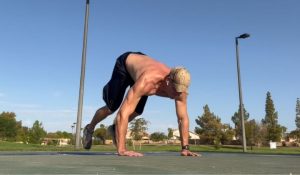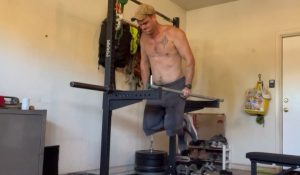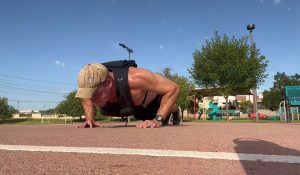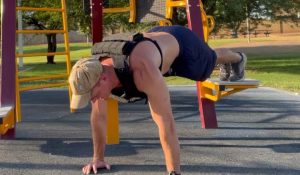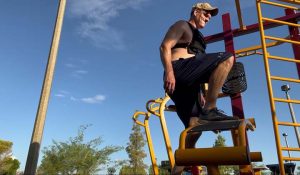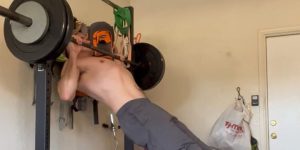A few years ago I went on a quest to find the perfect alternative to regular squats in a rack, and I stumbled across a lift that has become one of my all-time favorites: the behind the back deadlift.
The behind the back deadlift is a strength training exercise that primarily targets the muscles in the legs, hips, and lower back. It involves lifting a weight from the ground to the hips while standing with the feet in front of the barbell, rather than behind like in a conventional deadlift. This deadlift variation is perfect for lifters looking for a quad dominant barbell exercise that can be done from the floor, or for people looking for a no-rack barbell squat alternative.
I discovered a few more benefits along the way. In this article, we’ll discuss why you should consider incorporating the this unique exercise into your routine.
Benefits of the behind the back deadlift
It emphasizes the quads more than the traditional deadlift
If you’re looking for a lift that effectively splits the difference between the quadriceps demands of the barbell back squat with the posterior chain demands of the conventional deadlift, you’ve found it – the behind the back deadlift does exactly that.
Performing this lift feels very similar to the trap bar deadlift, another compound exercise that is praised for its ability to produce equal stimulus in the anterior and posterior chains simultaneously.
The difference? The behind the back deadlift doesn’t require you to buy or gain access to another expensive piece of specialized equipment (a trap bar).
If you’ve never tried this exercise before, you may be surprised by how much demand it places on the quadriceps.
It’s a very effective no-rack barbell squat alternative
As I mentioned above, I began using this lift during that fateful year where we all couldn’t go to the gym:

What I discovered was that the back deadlift gave me a surprisingly strong stimulus in my quads, while still retaining the posterior chain demands of a regular deadlift. After trying a few different variations of squats from the floor, I settled on this exercise as my “no rack” squat alternative of choice.
I believe that this lift (along with Jefferson deadlifts) is on a short list of viable no-rack squat alternatives from the floor.
It can be loaded much heavier than a front squat from the floor
When seeking out squat-like exercises that can be done from the floor (without a rack), the most common answer is to clean the weight into a front rack position and simply perform front squats.
While front squats, in general, are awesome, there is a glaring problem with this approach:
Unless you’re experienced on the Olympic lifts, it’s unlikely that you can power clean a weight heavy enough to provide a true strength stimulus on the front squat.
Simply using a lift that’s meant to be done from the floor (such as behind the back deadlifts, barbell hack squats, or Jefferson squats) completely eliminates this issue.
The punchline – behind the back deadlifts can be loaded heavy (almost as heavy as your traditional deadlift). If you’re after a strength stimulus, this loading this exercise with heavy weights is the better option.
Because it’s done from the floor, it fits perfectly into quick barbell circuits
Barbell circuit training is an underrated method of training for the time constrained lifter. Traditionally, we are taught to complete 3-5 sets of an exercise, resting 1-3 minutes between sets depending on the intention of the set. This is a fine way to train, if you’ve got the time.
If you don’t have the time, then barbell circuit training allows us to get a very similar stimulus, while using the rest periods to do other exercises.
For instance, one of my favorite barbell circuits is to pair a barbell floor press, barbell row, and behind the back deadlift in rapid succession. Rest 30-60 seconds after the circuit and repeat 3-5 times. This allows for between 9-15 strength-focused sets that can be completed in the time it would normally take you to do one exercise in the gym.
Muscles worked by deadlifting behind the back
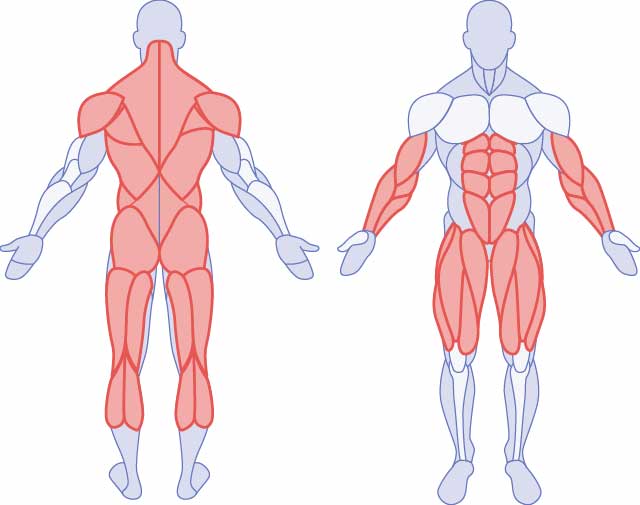
One of the reasons the deadlift behind the back is such a useful exercise is that it involves so many muscles. Think – deadlift muscles plus quads.
The prime movers in the behind the back deadlift are the hamstrings, quads, glutes, and spinal erectors. This means the exercise will build strength in a very similar way to a normal deadlift, squat, or trap bar lift.
However, many more muscles are engaged as well. The entire upper back will be contracted to stabilize the weight (lats, traps, rhomboids, rear delts), as well as the biceps, calves, and all of your trunk (core) musculature.
This means that most of the muscle mass in your body is worked by this unique exercise.
How to do the behind the back deadlift
- Set up your feet like you would for a normal, conventional deadlift, but while standing in front of the bar. Keep your heels about a shoulder width apart, toes pointed slightly outward (as is comfortable). Set your calves gently against the bar.
- Reach down and grab the bar with a normal deadlift grip (or, to emphasize the upper back / traps more, grab the bar with a wider grip). Feel free to use overhand grip or mixed grip, according to your preference. If grip strength is a limiting factor, you are welcome to use straps if you prefer.

- Breath and brace as in a normal deadlift, and pack your shoulders by engaging the lats. Keep the bar close to your calves.

- Begin the lift. The cue I use is “stand up!” Be sure to straighten your back angle enough as you ascend in order to avoid smacking yourself in the hamstrings with the bar.
- Lock out the range of motion as you would in a normal deadlift, and repeat.
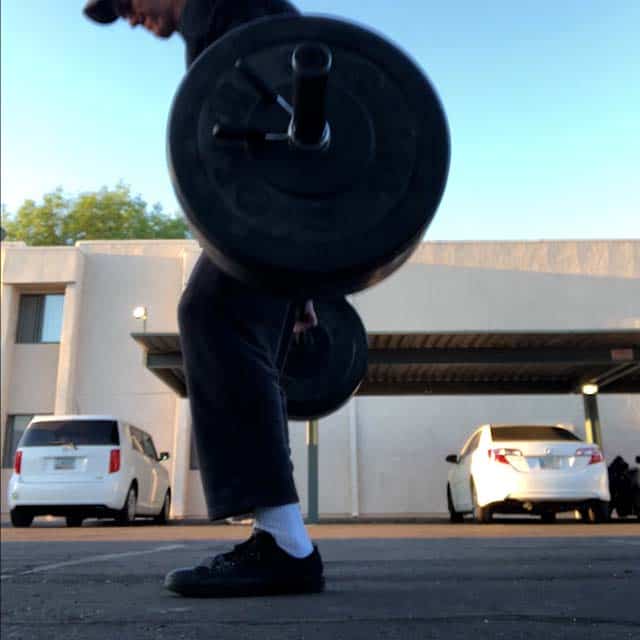
- Lock out the range of motion as you would in a normal deadlift, and repeat.

I find that this lift is best done in a touch-and-go fashion, where I’m not resetting the lift each time like I would on a heavy set of conventional deadlifts. This allows me to get a training stimulus from a slightly lighter weight (helpful in the context of circuit training).
That being said, it’s personal preference. Try both ways and see which one you prefer.
Pro tip: Avoid hitting the hamstrings with the bar
The most common issue with the behind the back deadlift is to smack yourself in the hamstrings with the barbell on your way up. Not only is pulling the weight into your legs painful, it can cause you to drop the bar if your grip isn’t strong enough!
(It’s also hilarious, if you see someone else do it …)
To avoid this, make sure you’re extending the hips as you ascend, rather than maintaining your back angle to the midpoint like you would on a conventional deadlift.
The first time you attempt this lift, you may wish to take a few more warm up sets than usual. It takes a bit of getting used to. Once you get the movement pattern down, you shouldn’t have any more problems.
Behind the back deadlift vs barbell hack squat
The savvy lifters among you may be asking, “so, what’s the difference between this exercise and the traditional barbell hack squat?”
While the two exercises do look similar, they actually provide quite a different stimulus. The barbell hack squat, known for it’s ability to smash the quads, involves placing a plate or wedge under the heels prior to the lift.
This adjustment allows the lifter to keep a much straighter back, track the knees much further out over the toes, and close the knee angle much further.
Traditionally, you would use much less weight on the barbell hack squat, and use smaller plates (load the bar up with 25’s or 10’s) in order to allow for a full stretch of the quads in the bottom.
The behind the back deadlift is a different beast. With the heels planted on the floor, the lifter must bend forward further in order to reach the bar. This is what provides the “deadlift” feeling in the exercise.
Done properly, the behind the back deadlift feels more like a regular squat done 2-3 inches above parallel.
Programming the deadlift behind the back
This versatile exercise can be included in many different types of programs, but in general, here are some parameters to utilize:
- For hypertrophy in the legs and back, utilize sets of 6-15 repetitions, and keep the rest periods around 1-2 minutes.
- For increased strength in the legs and core, utilize sets of 3-6 repetitions, and use longer rest periods (3-4 minutes).
- For time efficiency, incorporate this lift into a circuit style training session along with a pressing exercise and a pulling (back) exercise like rows or pull ups.
If you’re planning to utilize this exercise as a main lift, I would suggest programming this exercise 2-3 times per week, varying the rep ranges and intensities.
If you’re planning to utilize this exercise as a supplemental lift, then substitute it into your program in place of another, more traditional leg exercise.
Conclusion
The deadlift behind the back rocks! If you’ve never tried it, give it a try. For those of you who are attempting to get maximal results with minimal time investment, the deadlift behind the back is a great way to build muscle in the entire leg and develop full-body strength.






